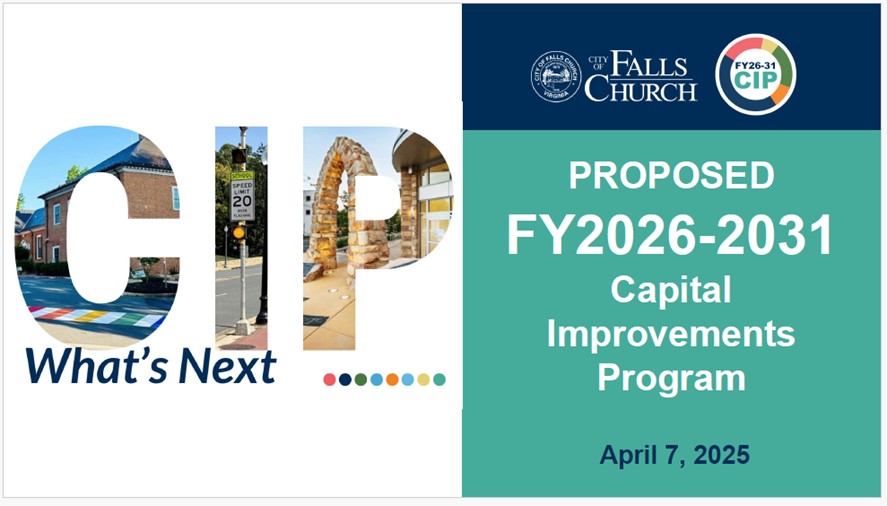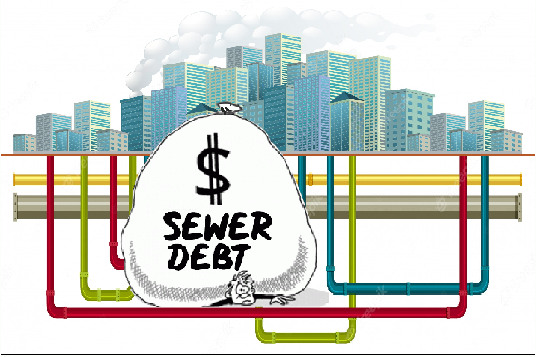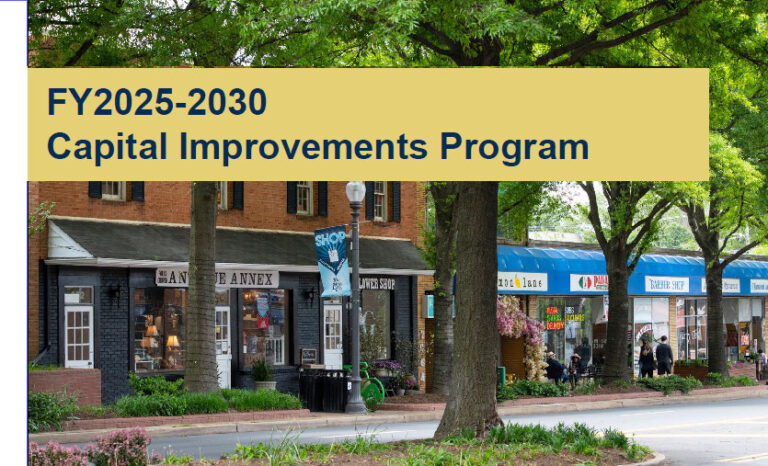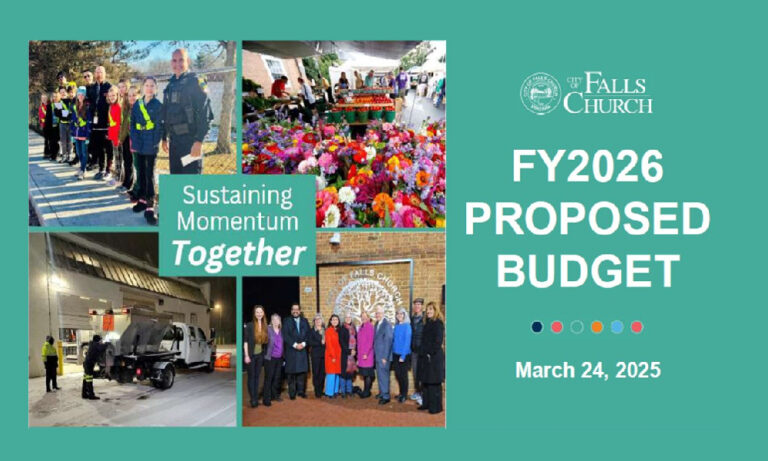FY2026-2031 CIP Budget – Major Sewer Infrastructure Project to Begin Soon
Summary
The six-year, $148 million Capital Improvements Program (CIP) budget focuses on transportation projects, the City property yard, and sewer infrastructure upgrades. This budget will require debt to be issued to fund $58 million, with grants providing $46.2 million.
For FY2026, the budget has been constrained by available staffing rather than funding. The much-needed traffic lights for Gresham Place, included in a large N Washington Street project, has been delayed until FY2028 even though funding is available.
$11.4 million for sewer infrastructure projects will be raised by issuing debt in FY2026. Staff have yet to provide details on how that debt service will be paid, but it will be through sewer charges rather than the City’s real estate taxes.
Background
CIP Coordinator Caitlin Sobsey presented the FY2026-FY2031 Capital Improvements Program (CIP) budget at the April 7, 2025, City Council work session. The CIP budget is a companion budget to the operational budget that was discussed at the March 24, 2025, City Council meeting.
Overview of the FY2026-2031 CIP
This CIP budget totals $148 million for the six-year period, smaller than last year ($189 million). Last year, the City made a major push to get many backlogged projects completed. This year’s more modest budget is planned with consideration for the workload on staff and focuses on what can realistically be done. The City continues to rely on contractors to manage many projects, but they also need supervision by City staff. Currently there are 38 active CIP projects that have a total budget of about $70 million, and not all require funding in FY2026.
The graphic below provides an overview of the six-year CIP budget. The table on the left shows the project categories and their costs, while the pie chart lists the funding sources. Pay-as-you-go (PAUG) refers to unassigned cash reserves that are available for spending. Capital reserves refer to funds that have been set aside specifically for CIP projects. “Fund Balance” refers to cash available in the stormwater and sewer utility funds. (Although the capital plans for these utilities are included in the CIP, their operational budgets are separated from the general government budget.)

Most of the grant funding received by the City is for transportation projects. According to Ms. Sobsey, the transportation projects are typically 60-70% grant funded. The anticipated $58 million in debt is for the property yard ($30 million), the expansion of the sewer infrastructure ($22.6 million), and replacement of the fire station roof ($5 million).
A summary of the CIP projects is provided at the end of this post. An overview of each project, is provided in the CIP budget document available on the City’s CIP webpage.
A note on federal grants
Ms. Sobsey said that $13.4 million of the funding in the CIP is from federal grants. Given the recent blocks placed by the Trump administration on certain federal grants, City staff is closely monitoring the status of these grants. To date, they have not been told of any holds or funding risks.
Sewer is the biggest expense in the FY2026 CIP budget
Only the funding for FY2026 will be appropriated when the City Council finalizes the budget on May 12; the remaining years in the budget are strictly for planning purposes. For FY2026, the CIP budget calls for spending $26.3 million as summarized in the graphic below.
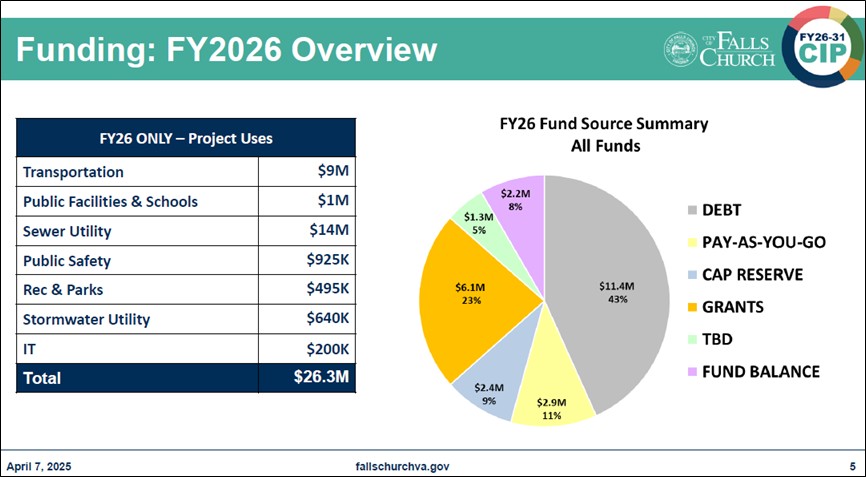
Sewer Utility projects represent the largest category in FY2026 at $14 million. The largest project is the construction of a flow equalization basin under Cavalier Trail Park – approximately $10 million. The remaining $4 million in sewer expenditures covers the City’s share of capital expenditures for the sewage facilities in Arlington and Fairfax, and rehabilitating the City’s infrastructure, e.g. relining sewer pipes and manhole covers.
According to the latest CIP budget, sewer funds from availability fees for new hookups were used in FY2025 to cover the $8.8 million payment to Fairfax County to increase the City’s sewage capacity limit. Insufficient funds remain so that a debt issue is needed for $11.4 million to cover these sewer projects. The debt may be issued as municipal revenue bonds or general obligation bonds, but the debt service will be paid through, presumably higher, quarterly sewage charges. Staff has yet to present their recommendations.
Gresham Place traffic lights delayed to at least 2028
Transportation projects, ongoing and new, will receive $9 million in funding, much of it from grants. But the N Washington Street Multimodal project that included a traffic signal at the Gresham Place intersection has been delayed to FY2028 because of staffing availability. The residents of Gresham Place had asked for this light to allow them to safely make a left turn into an increasingly busy N Washington Street.
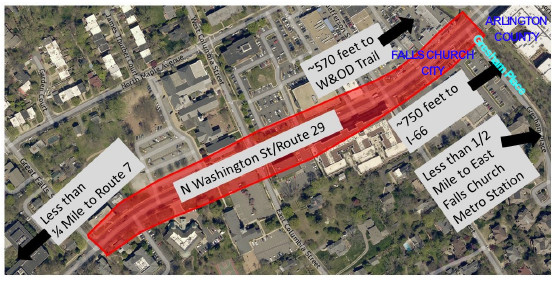
City Manager Wyatt Shields said staff recently learned that from Arlington County and the Virginia Department of Transportation (VDOT) that the City’s proposal of a “temporary fix” for the traffic light at Gresham Place will not work. The county and the state would like the entire N Washington Street to be redone at the same time, as planned in the N Washington St project that already has $22.5 million of grant funding. Deputy City Manager Andy Young said the City does not have the organizational capacity to take on such a large project at this time.
Mayor Letty Hardi said the residents at Gresham Place have been waiting for three years for a signal light and pressed staff to explore what could be done sooner. Council Member Erin Flynn suggested putting this project ahead of another, perhaps the Park Avenue Great Streets Project. Council Member David Snyder offered to reach out to his transportation contacts in Arlington and VDOT to explore interim solutions.
With respect to other transportation projects:

- Staff are awaiting grant approval to repave sections of Broad Street and Washington Street entirely with grant funding.
- Funding is included to begin work on the East/West Bike Connection described in the Bicycle Master Plan. This is the route that will connect the W&OD Trail to Mustang Alley and provide a safe bike route for school students.
- Work continues to construct six new bus shelters, and related pedestrian facilities such as crosswalks, along S Washington Street from S Maple Avenue to Graham Road. This is the second year of a three-year project funded with a federal grant.
- Lincoln Avenue roadbed reconstruction is part of the Greening of Lincoln project.
- Installation of four new Bikeshare stations at the following locations:
- S Oak Street near Fellows Court,
- Hillwood Avenue near the Tower Square Shopping Center,
- Park Place near the Broad and Washington Project, and
- the Birch & Broad Shopping Center.
Public facilities and schools projects
City Hall’s uninterruptable power supply (UPS) equipment is undersized and overloaded, risking power loss to critical systems during power outages. This CIP provides funds to address this problem and improve the cooling and ventilation in the telecommunications room.
$1.4 million has been budgeted in FY2026 and FY2027 to renovate Oak Street Elementary School so it can accommodate the projected increase in student enrollment.
Continuing projects include:
- installing 10-15 new fire hydrants a year to meet state minimum distance requirements,
- upgrading the security systems of all City-owned facilities to a centralized system, and
- reinvestments in the City’s 90+ vehicles.
Residents say CIP is lacking in paving and flood mitigation investments
At the April 3, 2025, budget town hall, City resident Andrew Olesen pointed out that the City’s current road paving schedule continues to fall short of the recommended 12-15 year replacement cycle. During last year’s budget meetings, former director of Public Works Zack Bradley reported that the City is on a 30-35 year repaving schedule that only extends the road life by 5-10 years. The more expensive roadbed reconstruction would extend road life by 20+ years.
City resident Fred Thompson appealed to the City to develop a comprehensive plan for managing stormwater runoffs and avoiding the City-wide flooding incidents that occurred as recently as 2019. City Manager Shields concurred that staff are aware that stormwater infrastructure is undersized, and current stormwater projects on Hillwood Avenue and the Greening of Lincoln address flooding issues in certain neighborhoods but not all. Mr. Thompson has written a Pulse post on this issue, Stormwater in the City: There’s Flooding in our Future!
Projects in the FY2026 CIP budget
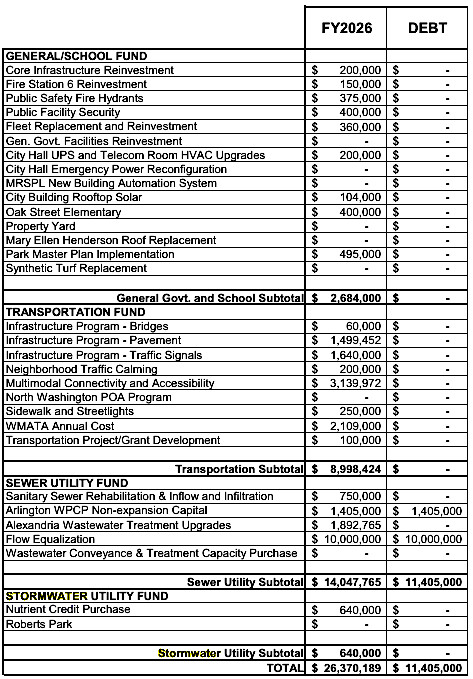
FY2025 Completed CIP projects

FY2026-2031 CIP Budget Summary

Reference
- City Council Work Session, April 7, 2025. YouTube video.
- City Council Work Session, April 7, 2025. This official video will not display properly on a small screen because it contains the agenda.
- FY2026-2031 CIP Presentation, April 7, 2025.
- Proposed FY2026-2031 Capital Improvements Program – Updated March 2024
- Capital Improvement Programs, City webpage.

